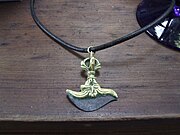Kartika (knife)

| Part of a series on |
| Tibetan Buddhism |
|---|
 |
A kartika or drigug (
While the kartika is normally held in the right hand of a dakini in Vajrayana iconography and spiritual practice, occasionally it can be seen being held by esoteric male deities,[4] such as certain forms of Yamantaka.[5] It is also found frequently in the iconography of the Tibetan Buddhist spiritual practice of Chöd.
Iconography
In terms of iconography,
The
The same way that the bell and vajra are usually paired ritual items in Vajrayana spiritual practice and iconography (one is held in the right hand and the other simultaneously held in the left), the kartika usually appears as a pair with the kapala (skull-cup), symbolizing the union of wisdom (kartika) and method (kapala).[6]
The shape of the kartika or drigug, with its crescent shape and the hook on the end, is derived from the shape of a traditional Indian butcher's knife.[3]
Depictions of Vajrayogini typically contain the kartika as one of her attributes. In the iconography of the enlightened dakinis and tantric female yidams, it is common to find the hooked kartika knife in her right hand and the skull cup in her left, representing "the inseparable union of wisdom and skillful means."[3]
Meanings
As one author writes about the meaning of the kartika:
The traditional interpretation of the hook in Tibetan Buddhist imagery is that of the hook of compassion. It is the hook which pulls beings out of the cycles of transmigration. The hooked crescent-shaped knife of the dakini with its vajra handle pulls one forth from suffering, chops up the ego-centred self and is guided by the diamond clarity of the vajra.[7]
The kartika is used to symbolize the severance of all material and worldly bonds and is often crowned with a
Gallery
-
Vajra kartari
-
Vajrayogini from thangka, holding kartari in her right hand
-
Example of a miniature kartari worn as adornment in contemporary times
-
Quartz kartari on display at Guimet Museum, 18-19th century
References
- ^ a b Beer (2003), p. 112.
- ^ Huntington & Bangdel (2004), p. 327.
- ^ a b c d Huntington & Bangdel (2004), p. 356.
- ^ a b c d Beer (2003), p. 114.
- ^ Anon (2020).
- ^ Harderwijk (2011).
- ^ Allione (1986), p. 32.
- ^ Beyer (1973), p. 111.
Works cited
- Allione, Tsultrim (1986). Women of Wisdom. London: Arkana. ISBN 1-85063-044-5.
- Anon (2020). "About Yamantaka/Vajrabhairava". Yamataka.org. Retrieved 2021-07-26.
- Beer, Robert (2003). The Handbook of Tibetan Buddhist Symbols. Boston: Shambhala.
- Beyer, Stephen (1973). The Cult of Tara: Magic and Ritual in Tibet. Berkeley, CA: University of California Press.
- Harderwijk, Rudy (2011). "Tantric Symbols". A View on Buddhism. Retrieved 2008-09-28.
- Huntington, John; Bangdel, Dina (2004). The Circle of Bliss: Buddhist Meditational Art, Columbus Museum of Art, Columbus, Ohio. Chicago: Serindia Publications.




